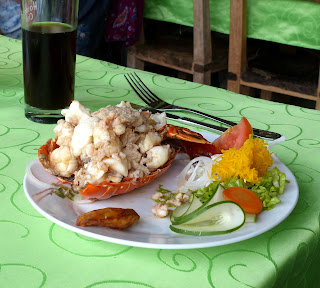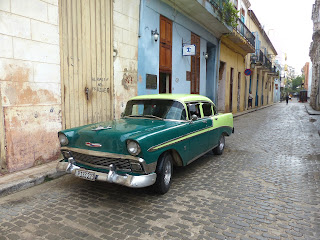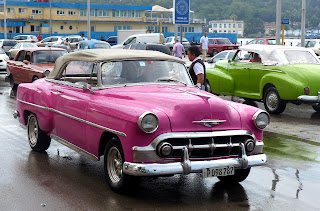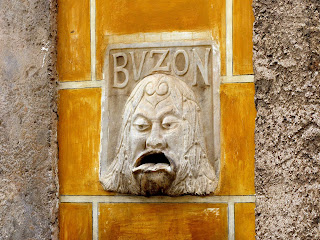A trip to Havana without a stop at Ernest Hemingway's Cuban home would be—to me—unthinkable, so we arranged a visit to the Municipio San Francisco de Paula to see "Lookout Farm," now the Museo Hemingway, maintained by the Cuban government, opened to the public in 1994.
The house is a one-story Spanish colonial built in 1886 or '87 by Catalan architect Miguel Pascual y Baguer on a hilltop 12.5 kilometers (or maybe 20 kilometers—accounts differ) south of Habana Vieja, about a twenty-minute taxi ride from our hotel. Hemingway and Martha Gellhorn rented the estate in 1939 for US$100 a month, and in 1940 with his first royalty check from For Whom the Bell Tolls, bought it for US$12,500 or US$18,500 (accounts differ). It sits on about 20 tree covered acres, the once open country around it now a suburb of mostly working-class houses.
A guard at the entrance to the long driveway collected 5 pesos each from us and we drove to the parking area below the original garage.
We walked past the garage, currently in the process of restoration but housing museum offices,
to the entrance to the main house.
For whatever reason (Hemingway's fallen standing, the distance from Havana central), few tourists were there when we visited; in fact, there were more custodians than visitors.
Cords prevented entry but all doors and most windows were open allowing a clear view of the interior, supposedly arranged as Hemingway left it in 1960. We walked around the house and photographed each room.
View through the front door.
Sitting room.
Two views of a study
and the trophy mount that dominates the wall.
Bedrooms.
Bath
and closet off the bath.
Another study
and trophy on the desk.
Dining room.
Back door.
View down the hill behind the house.
Mary Welsh had a four-story tower built so Ernest could write in privacy, but as the custodian told me, he did not write much there, preferring the bustle of the house.
I climbed the exterior stairs and looked in. The tower custodian offered to photograph from the inside.
She took a photo of the Corona on the table, the same model as my first typewriter. My grandfather gave it to me, a 1917 portable with only three rows of keys but with three levels of type on each key: lower case, upper case, the third level numbers and symbols. The roller is hinged to fold over the keyboard to fit the machine into a compact carrying case.
The name "Lookout Farm" is confirmed by the view from the tower.
Downtown Havana is visible in the distance.
From the tower, we walked down to the swimming pool and tennis court.
Another view of the Pilar.
The gazebo at the front of the house.
The gazebo at the pool.
A poster in the sitting room.
More photos on walls: Hemingway as a younger man.
Hemingway with a group that includes, according to the custodian who told us, Captain Gregorio Fuentes to whom Hemingway left the Pilar, and on whom, according to many reports, he based the “Old Man” in The Old Man and the Sea.
The house is a one-story Spanish colonial built in 1886 or '87 by Catalan architect Miguel Pascual y Baguer on a hilltop 12.5 kilometers (or maybe 20 kilometers—accounts differ) south of Habana Vieja, about a twenty-minute taxi ride from our hotel. Hemingway and Martha Gellhorn rented the estate in 1939 for US$100 a month, and in 1940 with his first royalty check from For Whom the Bell Tolls, bought it for US$12,500 or US$18,500 (accounts differ). It sits on about 20 tree covered acres, the once open country around it now a suburb of mostly working-class houses.
A guard at the entrance to the long driveway collected 5 pesos each from us and we drove to the parking area below the original garage.
We walked past the garage, currently in the process of restoration but housing museum offices,
to the entrance to the main house.
For whatever reason (Hemingway's fallen standing, the distance from Havana central), few tourists were there when we visited; in fact, there were more custodians than visitors.
Cords prevented entry but all doors and most windows were open allowing a clear view of the interior, supposedly arranged as Hemingway left it in 1960. We walked around the house and photographed each room.
View through the front door.
Sitting room.
Two views of a study
and the trophy mount that dominates the wall.
Bedrooms.
Bath
and closet off the bath.
Another study
and trophy on the desk.
Dining room.
Back door.
View down the hill behind the house.
Mary Welsh had a four-story tower built so Ernest could write in privacy, but as the custodian told me, he did not write much there, preferring the bustle of the house.
I climbed the exterior stairs and looked in. The tower custodian offered to photograph from the inside.
She took a photo of the Corona on the table, the same model as my first typewriter. My grandfather gave it to me, a 1917 portable with only three rows of keys but with three levels of type on each key: lower case, upper case, the third level numbers and symbols. The roller is hinged to fold over the keyboard to fit the machine into a compact carrying case.
The name "Lookout Farm" is confirmed by the view from the tower.
Downtown Havana is visible in the distance.
From the tower, we walked down to the swimming pool and tennis court.
The pool is reputed to be where, while Mary
napped in the house up the hill, Hemingway and Ava Gardner made love and she swam nude. After watching her swim, Hemingway is
reported to have ordered his staff: "The water is not to be emptied." Alas, the pool is now dry.
The tennis court is berth for Hemingway’s 38-foot cabin cruiser, Pilar.
Despite reports, it seemed in good shape, although perhaps not seaworthy.Another view of the Pilar.
The gazebo at the front of the house.
The gazebo at the pool.
A poster in the sitting room.
More photos on walls: Hemingway as a younger man.
Hemingway with a group that includes, according to the custodian who told us, Captain Gregorio Fuentes to whom Hemingway left the Pilar, and on whom, according to many reports, he based the “Old Man” in The Old Man and the Sea.


























































































































